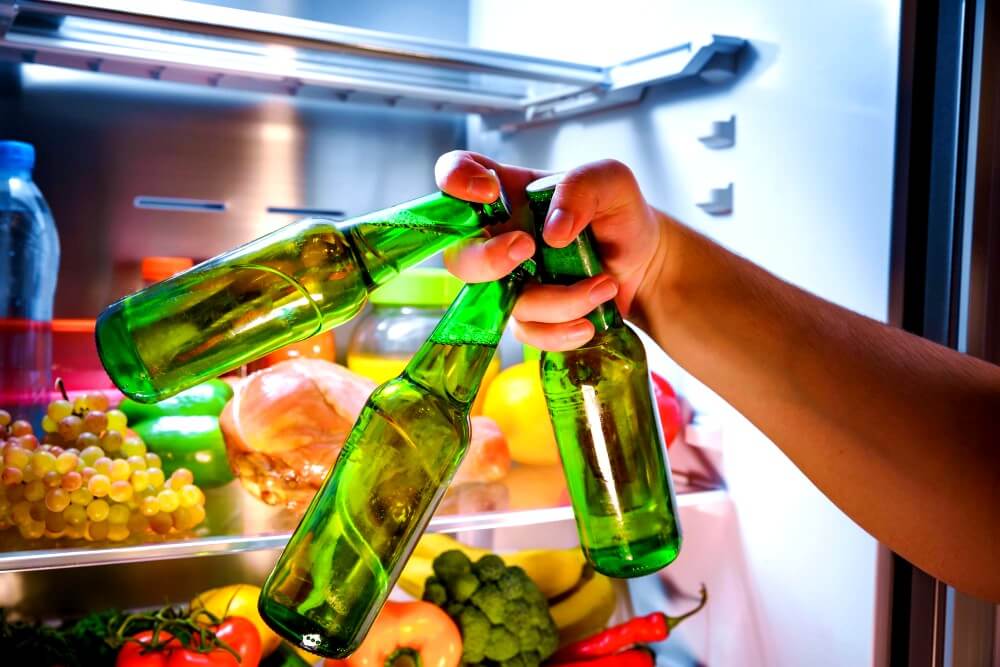How Many Beers Fit in a Fridge for home use?
This question gets asked a lot, and there is no easy answer. The best answer to this question is that it depends. It depends on the type and size of fridge you have and what types and sizes of beers are stored in your fridge. The following discussion will try to deal with these aspects in turn.
Read More: A Comprehensive Guide to the Best Beer Fridge for Your Home
How many beers fit into a domestic refrigerator?
I remember when I moved into my first apartment, there was only one way I had to measure how many 12 packs would fit into my new refrigerator: by physically trying them out! Oh yes, it took me several hours, but finally, I discovered that we could squeeze six big fat German “Erdinger” wheat beer bottles side-by-side into the door shelves of my 2-year-old Swedish-built “frigidaire.”
Shape Matters
The shape of the refrigerator is essential. The more cubic space you have, measured in liters or cubic feet, the more beer will fit. If you have an old fridge with separate chambers, it’s usually best to stack your beer bottles vertically. This maximizes the available vertical space and allows many more to be stored in the same horizontal area compared to keeping them horizontally on their sides.
The worst stacking arrangement is often seen where someone uses every last bit of available horizontal shelf space and stores one bottle standing up behind two others lying down on their sides, resulting in 3 shelves instead of just 2! This usually leads to a messy jumble when removing or rearranging items.
Be careful if storing beers horizontally because most swing-out shelves have limited load capacities, even if you manage to fit in all 24 or 30 beers like you originally planned!
Stacking full beer bottles vertically
Be careful when stacking full beer bottles vertically that the weight of the bottom one does not cause the top one to fall off, thus wasting your precious beer. There is a risk here also that many converging shelves at the front may not hold any vertical stacks securely.
I think it’s worth ensuring that these are adequately supported independently of each other and the fridge wall by properly using something such as some scrap wood supporting cross bars between them. If you get into a situation where this isn’t possible, consider only storing unopened beers upright with space behind them so they remain stable.
Remember also that it’s best to store beers of a similar size vertically together because they have identical weight distribution characteristics. For example, it’s often best to store cans side by side and not on top of each other unless your fridge is full.

A Good Practice
I’ve found that it is also good practice to place larger bottles standing up: this improves air circulation around the bottles more than storing them lying down. Finally, if you have sufficient vertical space, consider using “stubbies” upright and use only part of the longer shelves for these so as not to waste too much valuable horizontal shelving area in your refrigerator.
It is possible to improve beer shelf life by increasing the air circulation by doing or where otherwise, there are limited options available within the confines of your fridge design.
What if the Refrigerator is Horizontal?
If you have a good-sized horizontal refrigerator, it can fit many more beer bottles lying down than standing up. I’ve managed to get 30 big ones horizontally in my current 2-year-old fridge with quite a bit of effort! It’s not recommended, though, because the increased temperature range leads to a poorer quality beer after just one week.
It is also worth noting that putting cold beers into an already warm fridge can sometimes lead to condensation leading to wet labels and even beer bottle sweating (which isn’t necessarily bad for you but still comes at some costs). This means you should ensure your fridge stays close to your ideal storage conditions before loading it with the fresh beer you’ve just brought.
Don’t forget that a warm fridge will cause a beer to heat up when it warms up as you open the door for access all day or while you’re making dinner.
Chest Freezer
If you have a chest freezer, your options are more limited because of how they work. You can fit many more lying down, especially if you store cans and stubbies horizontally. Remember again; the increased temperature range leads to poorer beer quality compared with proper storage in optimum conditions (upright).
If you don’t have enough space, vertical stacking is not usually possible unless you use dedicated stackable plastic beer crates with more significant gaps between them than average shelves allow. It’s good practice to leave some unfilled shelf space at the back of chest freezers to improve cold air circulation around the frozen food.

If you can’t store your beer any other way, try to make sure it’s not touching the walls, which are always warmer than the center of the chest freezer (unless you have a horizontal one). If it has to go near the walls, try to maximize spacing between each bottle/can and avoid significant gaps with just one or two bottles.
For best results, don’t put beers in direct contact with each other even if they’re in an upright position; always leave some space between them vertically for better heat distribution throughout them individually and increase their shelf life. Also, consider whether there aren’t any opened ones that could be stored elsewhere and if there are, move them because they keep on giving off carbon dioxide until the last drop is gone.
Avoid the Door Storage Areas
Do not store beer cans or bottles in door storage areas: this causes a considerable temperature swing each time you open it (one of the most extreme places in your refrigerator). The same goes for underneath one of those silly wire shelving units for fresh produce that sometimes comes with fridges – I’ve seen some minimal research to support this advice but none on its long-term effects.
Many people have told me about their own experiences, though! Also, never stack anything atop beer in an upright position unless adequately designed for such an application. It’s simply too easy to knock things over and cause damage or break glass bottles containing beer you’ve worked so hard to keep good. If you want to store things on top of the beer, I recommend storing them next to it or within a box for maximum protection.
How Many Beers Fit in a Fridge: Final Words
I think the most important thing is to try and buy as few beers as possible at any one time, especially if they’re all from the same brewery – even when purchasing different varieties – because this reduces your exposure risk. Also, this allows you more flexibility in where and how you store them, reducing temperature fluctuation at both ends of their shelf life (between 7-30 days, depending on style).
Finally, you can be extra safe about freshness by using cans rather than bottles because they don’t have a hole through which oxygen enters, and carbon dioxide escapes during storage, naturally making beer stale faster.





